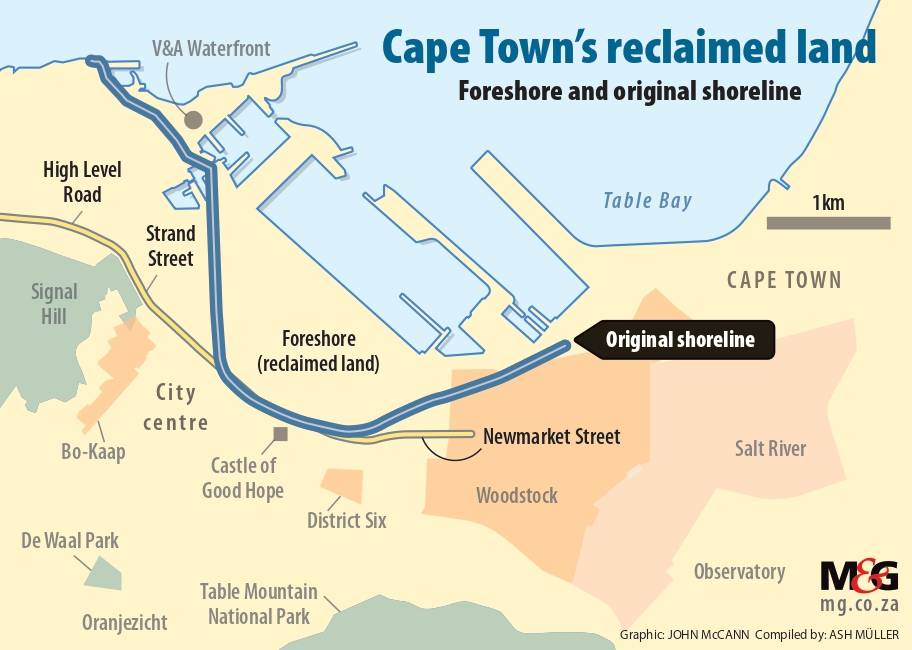Plush: The Cape Wheel was recently relocated to the Granger Bay precinct at V&A Waterfront, the area marked for new development. Photo: Supplied
It’s not Cape Town’s first rodeo when it comes to reclaiming land from the sea. The Mother City has a history when it comes to physically pushing the sea back to make more land available for development.
Almost a century ago, what we know as the Foreshore and the V&A Waterfront was under the ocean. In 1935 work began to upgrade the harbour and to reclaim land for industrial and commercial development. The reclamation, carried out by a Dutch company, was due to be completed in 1941 but World War II intervened and it was concluded in 1945.
About 194 hectares of land was reclaimed and they moved the shoreline into the ocean by 1.6km.
Where the Castle of Good Hope stands now the sea could reach its walls. Woodstock had a beach.
Even on the world stage, this was a pretty maverick project for its time.
The Foreshore is between the city centre and the port. Today, the Foreshore is a buzzing node in the City Bowl. The land reclamation of the Foreshore and Table Bay where the V&A Waterfront Shopping Mall is situated gave Cape Town the room to grow.
With few limits on heritage and zoning laws, many redevelopment projects are lining the Foreshore precinct’s main roads. But the reclamation probably saved many older buildings from being demolished for redevelopment.
Some of the more exciting redevelopments have been The Onyx, Zeeland Pier I and Zeeland Pier II, The Duke, and the most recent renovation of the Radisson.
I visited the Radisson last month; it looks fabulously modern inside, with bountiful bouclé and other warm interior design elements. Foreshore real estate always has nautical nuances in interior design and an art deco vibe in architecture. Naturally, the ocean bordering the suburb is the main inspiration for the look and feel.
Fast forward to today, and the V&A Waterfront has released some of the most exciting news since the 1930s. A rezoning application has been submitted to the City of Cape Town to reclaim an additional 440 000m2 of development rights across its current footprint.
Coastal protection will need considerable improvement. One must ask what the environmental impact of expanding into the sea will be. With predicted rising sea levels as a result of climate change, could Cape Town ground be vulnerable to such a large reclamation project?
The V&A Waterfront has commissioned several environmental impact studies on the Granger Bay expansion project. With climate change scientists having projected that sea levels will rise 2mm every year and that severe weather events will increase, this needs to be considered when any new developments are to be built along the coastline.
Most of this land will be allocated for new construction in the Granger Bay precinct, where more land will be reclaimed from the ocean to make way for mixed-use developments, including retail spaces, restaurants, hotels and residential apartments. There will be considerable public and cultural facilities, which will involve re-establishing public access to the shoreline.
The Granger Bay precinct is located in the northwest section of the V&A Waterfront. It extends from the helipad north of Victoria Basin to Beach and Haul roads. This area is home to several establishments, including the Oceana Power Boat Club, Grand Africa Café & Beach restaurant, and the Oranjezicht City Farm Market, which will move to a new location in Granger Bay, overlooking the bay and closer to the new position of the Cape Wheel. This is scheduled for the first quarter of 2025.
Next to the market, a new parking lot of a few storeys was opened not too long ago. It was to serve the customers for the market and the Lookout venue next door.
This structure was temporary and is demountable, which means the V&A Waterfront will probably reposition this parking set-up too.
The V&A Waterfront precinct is 50% owned by Growthpoint Properties (the largest listed property fund in South Africa), while the Public Investment Corporation owns 50% on behalf of the Government Employees Pension Fund.
 (Graphic: John McCann/M&G)
(Graphic: John McCann/M&G)
Donald Kau, the head of public relations at the V&A Waterfront, said the R20 billion development plan will be rolled out in phases over the next 15 to 20 years, with plans to break ground in 2025.
The land use application was made available for public comment in July this year.
After the recent development of the Silo precinct and Canal districts, the V&A Waterfront hopes that the rezoning application will allow it to create additional residences in the Waterfront, enhance public areas, foster economic development and job creation and create new pathways to the sea.
Other aspects for development in the Granger Bay area include a public pathway that will link the city centre to Mouille Point, which will connect with the Atlantic Seaboard promenade.
One concept being considered is to develop a new public bay area that coastal protection measures would surround. This new space would provide opportunities for opening public access to a new protected area (with public amenities) suitable for swimming.
The last time Cape Town saw an infrastructure project this large was for the Soccer World Cup, which we hosted in 2010. The new Cape Town Stadium alone cost R4.5 billion.
I look forward to seeing how the ever-innovative V&A Waterfront precinct evolves over the next decade, thanks to this exciting investment in the pipeline.
Ask Ash is a new column that examines South Africa’s property, architecture and living spaces. Continue the conversation with her on email ([email protected]) and X (@askashbroker).